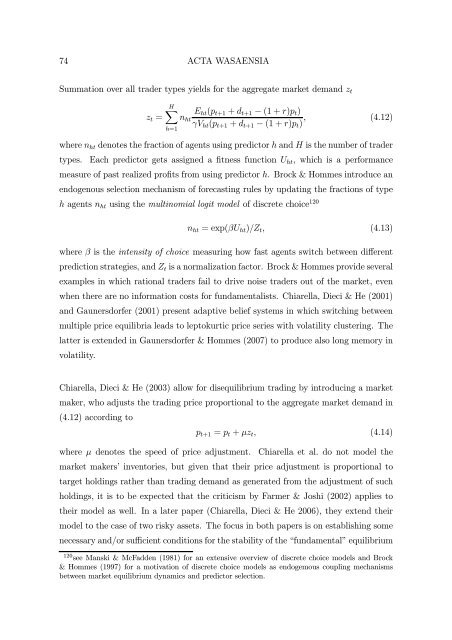BERND PAPE Asset Allocation, Multivariate Position Based Trading ...
BERND PAPE Asset Allocation, Multivariate Position Based Trading ...
BERND PAPE Asset Allocation, Multivariate Position Based Trading ...
Create successful ePaper yourself
Turn your PDF publications into a flip-book with our unique Google optimized e-Paper software.
74 ACTA WASAENSIASummation over all trader types yields for the aggregate market demand z tz t =Hh=1n htE ht (p t+1 + d t+1 − (1 + r)p t )γV ht (p t+1 + d t+1 − (1 + r)p t ) , (4.12)where n ht denotes the fraction of agents using predictor h and H is the number of tradertypes. Each predictor gets assigned a fitness function U ht , which is a performancemeasure of past realized profits from using predictor h. Brock & Hommes introduce anendogenous selection mechanism of forecasting rules by updating the fractions of typeh agents n ht using the multinomial logit model of discrete choice 120n ht =exp(βU ht )/Z t , (4.13)where β is the intensity of choice measuring how fast agents switch between differentprediction strategies, and Z t is a normalization factor. Brock & Hommes provide severalexamples in which rational traders fail to drive noise traders out of the market, evenwhen there are no information costs for fundamentalists. Chiarella, Dieci & He (2001)and Gaunersdorfer (2001) present adaptive belief systems in which switching betweenmultiple price equilibria leads to leptokurtic price series with volatility clustering. Thelatter is extended in Gaunersdorfer & Hommes (2007) to produce also long memory involatility.Chiarella, Dieci & He (2003) allow for disequilibrium trading by introducing a marketmaker, who adjusts the trading price proportional to the aggregate market demand in(4.12) according top t+1 = p t + μz t , (4.14)where μ denotes the speed of price adjustment. Chiarella et al. do not model themarket makers’ inventories, but given that their price adjustment is proportional totarget holdings rather than trading demand as generated from the adjustment of suchholdings, it is to be expected that the criticism by Farmer & Joshi (2002) applies totheir model as well. In a later paper (Chiarella, Dieci & He 2006), they extend theirmodel to the case of two risky assets. The focus in both papers is on establishing somenecessary and/or sufficient conditions for the stability of the “fundamental” equilibrium120 see Manski & McFadden (1981) for an extensive overview of discrete choice models and Brock& Hommes (1997) for a motivation of discrete choice models as endogemous coupling mechanismsbetween market equilibrium dynamics and predictor selection.
















